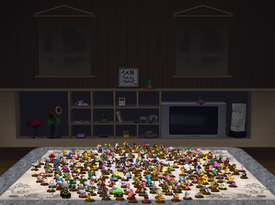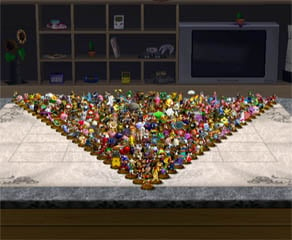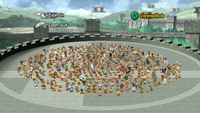Collection: Difference between revisions
m (Fixing link to point towards the Game Boy universe's article.) |
|||
| Line 11: | Line 11: | ||
The consoles that appear in the background are dependent on what version is being played: | The consoles that appear in the background are dependent on what version is being played: | ||
*In all versions, the [[Nintendo GameCube]], [[Nintendo 64]], [[ | *In all versions, the [[Nintendo GameCube]], [[Nintendo 64]], [[Game Boy]], Game Boy Advance and Game Boy Color appear, as well as a television set with the words [[HAL Laboratory|"Hal Laboratory Inc."]] on it. All versions also have a copy of ''[[Super Smash Bros.]]'' in the Nintendo 64, with a box nearby; the design of the box and cartridge vary in appearance with the region. | ||
*In the Japanese version features the [[Wikipedia:Famicom|Famicom]] and [[Wikipedia:Super Famicom|Super Famicom]], as well as the Virtual Boy; owners of the North American version can view these by changing the game language to Japanese. | *In the Japanese version features the [[Wikipedia:Famicom|Famicom]] and [[Wikipedia:Super Famicom|Super Famicom]], as well as the Virtual Boy; owners of the North American version can view these by changing the game language to Japanese. | ||
*The North American and [[PAL]] versions do not feature the Virtual Boy at all, due to the console's failure in America and its subsequent cancelled release in Europe. Additionally, both games have a NES and SNES instead of the Famicom and Super Famicom. | *The North American and [[PAL]] versions do not feature the Virtual Boy at all, due to the console's failure in America and its subsequent cancelled release in Europe. Additionally, both games have a NES and SNES instead of the Famicom and Super Famicom. | ||
Revision as of 17:22, August 8, 2014
Collection, referred to as the Trophy Hoard in Brawl, is a mode present in both Melee and Brawl that allows the player to view all of the trophies they have collected up to that point. Differences between the two versions exist, but both have the same overall purpose in the game.
In Super Smash Bros. Melee
As stated earlier, the mode allows the player to view all of their trophies in the game at that point; the player can zoom in and out on the trophies by using the X and Y buttons, as well as pan the camera using the Control Stick; pressing A returns the camera to its original position.
The room that the trophies are showcased in is similar to that of an ordinary bedroom, with a hardwood floor and two windowshades, each which have the Smash logo on them; the trophies rest on a marble table with what appears to be a paper or cloth covering, with a grid on it. The table itself resides in front of a multitude of shelves that feature many Nintendo consoles up to the release of Melee; these only appear after the player has attained a larger number of trophies.
The consoles that appear in the background are dependent on what version is being played:
- In all versions, the Nintendo GameCube, Nintendo 64, Game Boy, Game Boy Advance and Game Boy Color appear, as well as a television set with the words "Hal Laboratory Inc." on it. All versions also have a copy of Super Smash Bros. in the Nintendo 64, with a box nearby; the design of the box and cartridge vary in appearance with the region.
- In the Japanese version features the Famicom and Super Famicom, as well as the Virtual Boy; owners of the North American version can view these by changing the game language to Japanese.
- The North American and PAL versions do not feature the Virtual Boy at all, due to the console's failure in America and its subsequent cancelled release in Europe. Additionally, both games have a NES and SNES instead of the Famicom and Super Famicom.
Along with the consoles, the Japanese version also features calligraphy on the very top of the shelves, spelling out the Japanese name for the series, "Dairantō Sumasshu Burazāzu" in hirigana, katakana and kanji characters; as calligraphy is not widespread in North American or PAL regions, this image is replaced by that of a Mondrian-esque picture with the words "Super Smash Bros."
The layout of the trophies is completely random, with spaces frequently appearing between them. The player, however, can hold the L, R, or Z buttons to allow for different and neater arrangements; the combinations can give either a rectangle, a circle or a triangle.
The Collection makes a brief appearance at the end of all the Single Player modes as well. Upon clearing the final stage, a cutscene shows the player's character falling in a tumbling state, then turning into a trophy and finally landing on a surface shrouded with shadows; the camera then pans out, showing the trophy on the table, along with any other character trophies the player has attained in the background.
Of note is that after completing any of the Single Player games, there are six differently-coloured Game Boy Colors in the corner of the shelves; they disappear in the Collection mode.
The Collection as it appears after completing Classic mode with all characters; note the six Game Boy consoles in the corner.
In Super Smash Bros. Brawl
The Collection mode reappears in Brawl as Trophy Hoard. While it reprises its original function, it has dramatic differences from its Melee incarnation.
The setting of the Hoard is now completely different. Instead of an ordinary room, all the trophies are instead displayed on what appears to be a clearing on a parapet; the walls of a castle lined with small flags with the Smash symbol appear in the background, as well as a bright sky. The grid has been removed in favor of a large Smash logo. The consoles and other props have been removed as well, and the player can no longer control the layout of the trophies.
The Trophy Hoard also gives the player the ability to use the Diorama Mode; the player can take any four trophies that they have and arrange them however they need on a selection of four backgrounds. Afterward, the player, using a menu not unlike the Camera feature in normal gameplay, can take snapshots of the arrangement of trophies.
The Hoard still appears at the end of Single Player modes, though only for Classic and All-Star. However, the player's character instead immediately drops down as a trophy; when they land, the other character trophies are immediately arranged in a predetermined order, unlike the random placement of Melee.
Gallery
| Super Smash Bros. Brawl menu items | |
|---|---|
| Group | Brawl (Time · Stock · Coin Battle · Team Battle) · Rules · Special Brawl · Rotation · Tourney · Names |
| Solo | Classic · All-Star · Adventure Mode: The Subspace Emissary · Events · Stadium (Target Smash!! · Home-Run Contest · Multi-Man Brawl · Boss Battles) · Training |
| Wi-Fi | Spectator Mode · With Anyone · With Friends |
| Vault | Trophies & Stickers (Trophy Gallery · Trophy Hoard · Coin Launcher · Sticker Album · Sticker Center) · Stage Builder · Album · Challenges · Replays · Masterpieces · Chronicle |
| Options | Screen · Deflicker · Rumble · Controls · Sound · My Music · Erase Data |
| Data | Movies · Records (Group Records · Brawl Records · Notices) · Sound Test |







